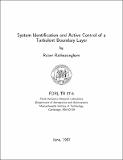System Identification and Active Control of a Turbulent Boundary Layer
Author(s)
Rathnasingham, Ruben
DownloadFDRL_TR-97-6.pdf (674.8Kb)
Metadata
Show full item recordAbstract
An experimental investigation is made into the active control of the near-wall region of a turbulent boundary layer using a linear control scheme. System identification in the boundary layer provides optimal transfer functions that predict the downstream characteristics of the streamwise velocity and wall pressure fluctuation using an array of upstream flush-mounted sensors that are sensitive to spanwise shear. Enhanced detection techniques isolated the large scale turbulent motion and improved the downstream correlations resulting in greater controllability. The techniques were based on the conditioned spectral analysis between adjacent sensors to extract the most correlated flow structures that span the distance between them. The control is applied using a spanwise array of resonant actuators that introduce a pair of streamwise vortices into the flow. Control experiments were carried out for single and multiple input/output configurations. The single output results show that a maximum reduction of 34% is achieved in the streamwise velocity fluctuation. This reduction is greatest at the point of optimization but spans over a few hundred viscous lengths downstream of the actuator and about 50 viscous lengths in the spanwise and wall-normal directions. The wall pressure fluctuation and the mean wall shear stress (measured approximately using mean velocity profiles near the wall) was reduced by 17% and7% respectively. The multiple-input/single-output configuration resulted in a wider spatial influence of the control while maintaining the maximum reductions in the fluctuations. The multiple-input/multiple-output configuration showed a marked increase in the spatial extent of the control (primarily in the spanwise direction), at the expense of a lower reduction in the fluctuations (maximum of 30% and 15% for the streamwise velocity and wall pressure respectively). The bursting frequency was computed from a VITA algorithm applied to the streamwise velocity fluctuation. The bursting frequency was reduced at all threshold levels examined but the maximum reduction of 23% occurred at a threshold level of 3. The span-wise spatial correlation was measured at different streamwise locations downstream of the actuator array. This result suggests that the reduction in turbulent fluctuations obtained using the current control scheme was achieved by reducing the strength of the most coherent flow structures and to inhibit their ability to interact with each other by increasing their average spanwise separation by more than 25% (from ≈ 90l* to 120l*).
Date issued
1997-06Publisher
Aerospace Computational Design Laboratory, Dept. of Aeronautics & Astronautics, Massachusetts Institute of Technology
Series/Report no.
ACDL Technical Reports;FDRL TR-97-6